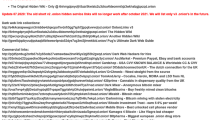Abstract
This paper examines a predominantly Australian sample of computer crime offenders involved in fraud and/or unauthorised access. This paper focuses on the extent to which offenders are involved in organised crime, the nature of the relationship between co-offending, initiation and knowledge transmission, and how the online environment facilitates organised crime and co-offending. This qualitative analysis draws from interviews with self-identified offenders, law enforcement officers who investigate these offenses, and court documents, providing a unique understanding of organised crime involving computer systems.
Similar content being viewed by others
References
Lusthaus, J. (2013). How organised is organised cybercrime? Global Crime, 14(1), 52–60.
Felson, M. (1998). Crime and everyday life (2nd ed.). Thousand Oakes: Pine Forge Press.
Chantler, A. N. (1995). Risk: The Profile of the Computer Hacker. Curtin University.
Meyer, G. R. (1989). The Social Organization of the Computer Underground. Northern Illinois University.
Holt, T. J. (2007). Subcultural evolution? Examining the influence of on- and off-line experiences on deviant subcultures. Deviant Behaviour, 28(2), 171–198.
Jordan, T., & Taylor, P. (1998). A sociology of hackers. The Sociological Review, 46(4), 757–780.
Yar, M. (2013). Cybercrime and society (2nd ed.). London: SAGE Publications Ltd.
AusCERT. (2006). Australian 2006 computer crime & security survey. Brisbane: AusCERT.
Smith, R. G. (2001). Trends & issues in crime and criminal justice No. 202: Cross-border economic crime: The agenda for reform. Canberra: Australian Institute of Criminology.
Brenner, S. W. (2007). Cybercrime: Re-thinking crime control strategies. In Y. Jewkes (Ed.), Crime online. Devon: Willan Publishing.
Wall, D. S. (2007). Cybercrime: The transformation of crime in the information age. Cambridge: Polity Press.
Goode, S., & Cruise, S. (2006). What motivates software crackers? Journal of Business Ethics, 65, 173–201.
Shaw, E., Ruby, K. G., & Post, J. M. (1998). The insider threat to information systems: The psychology of the dangerous insider. Security Awareness Bulletin, 98(2), 1–10.
Finch, E. (2007). The problem of stolen identity and the Internet. In Y. Jewkes (Ed.), Crime online. Devon: Willan Publishing.
Chu, B., Holt, T. J., & Ahn, G. J. (2010). Examining the Creation, Distribution and Function of Malware On-Line: Technical report for the National Institute of Justice.
Franklin, J., Paxson, V., Perrig, A., & Savage, S. (2007). An inquiry into the nature and causes of the wealth of internet miscreants. Paper presented at the ACM Conference on Computer and Communications Security (CCS), Virginia, October 29-November 2
Holt, T. J., & Lampke, E. (2010). Exploring stolen data markets online: products and market forces. Criminal Justice Studies: A Critical Journal of Crime, Law and Society, 23(1), 33–50.
Motoyama, M., McCoy, D., Levchenko, K., Savage, S., & Voelker, G. M. (2011). An analysis of underground forums. Paper presented at the 2011 ACM SIGCOMM conference on Internet measurement, Berlin, November 2–4
Choo, K.-K. R. (2007). Trends & issues in crime and criminal justice No. 333: Zombies and botnets. Canberra: Australian Institute of Criminology.
United Nations Office on Drugs and Crime. (2004). United Nations convention against transnational organized crime and the protocols thereto. Vienna: United Nations Office on Drugs and Crime.
Choo, K.-K. R., & Smith, R. G. (2008). Criminal exploitation of online systems by organised crime groups. Asian Journal of Criminology, 3(1), 37–59.
Choo, K.-K. R. (2008). Organised crime groups in cyberspace: a typology. Trends in Organized Crime, 11(3), 270–295.
Grabosky, P. (2007). Requirements of prosecution services to deal with cyber crime. Crime, Law & Social Change, 47(4–5), 201–223.
Theohary, C. A., & Rollins, J. (2011). Terrorist use of the internet: Information operations in cyberspace. Washington, DC: Congressional Research Service.
Smith, R. G., McCusker, R., & Walters, J. (2010). Trends & issues in crime and criminal justice No. 394: Financing of terrorism: Risks for Australia. Canberra: Australian Institute of Criminology.
Seib, P. (2008). The Al-Qaeda media machine. Military Review, 88(3), 74–80.
Barber, R. (2001). Hackers profiled - who are they and what are their motivations? Computer Fraud & Security, 2(1), 14–17.
Chantler, A., & Broadhurst, R. (2006). Social engineering and crime prevention in cyberspace - technical report. Brisbane: Queensland University of Technology.
Furnell, S. (2002). Cybercrime: Vandalizing the information society. London: Pearson Education Limited.
Taylor, P. A. (1999). Hackers. London: Routledge.
Berg, B. L. (2007). Qualitative research methods for the social sciences (6th ed.). Boston: Pearson Education, Inc.
Edney, R., & Bagaric, M. (2007). Australian sentencing: principles and practice. New York: Cambridge University Press.
Farrington, D. P. (1989). Early predictors of adolescent aggression and adult violence. Violence and Victims, 4(2), 79–100.
Wright, R. T., Decker, S. H., Redfern, A. K., & Smith, D. L. (1992). A snowball’s chance in hell: doing field research with residential burglars. Journal of Research in Crime and Delinquency, 29(2), 148–157.
Sutherland, E. H., & Cressey, D. R. (1974). Criminology (9th ed.). Philadelphia: J. B. Lippincott Company.
McAdams, D. P. (2008). The Life Story Interview. http://www.sesp.northwestern.edu/docs/LifeStoryInterview.pdf. Accessed November 12 2009.
Wright, R., & Bennett, T. (1990). Exploring the offender’s perspective: Observing and interviewing criminals. In K. L. Kempf (Ed.), Measurement issues in criminology (pp. 138–151). New York: Springer-Verlag New York Inc.
Israel, M. (2004). Strictly confidential?: integrity and the disclosure of criminological and socio-legal research. British Journal of Criminology, 44(5), 715–740. doi:10.1093/bjc/azh033.
Gibbs, G. (2007). Analyzing qualitative data. London: SAGE Publications Ltd.
Smith, R. G., Grabosky, P., & Urbas, G. (2004). Cyber criminals on trial. Cambridge: Cambridge University Press.
Acknowledgments
I would like to thank those who participated in this study and the assistance provided by the Australian Federal Police, the Queensland Police Service, Western Australia Police, and Victoria Police. I also appreciate the support of my supervisors, Dr Hennessey Hayes, Associate Professor Janet Ransley, Professor Simon Bronitt, and Professor Peter Grabosky, and acknowledge the assistance of the School of Criminology and Criminal Justice and the ARC Centre of Excellence in Policing and Security at Griffith University in undertaking my doctorate.
Author information
Authors and Affiliations
Corresponding author
Rights and permissions
About this article
Cite this article
Hutchings, A. Crime from the keyboard: organised cybercrime, co-offending, initiation and knowledge transmission. Crime Law Soc Change 62, 1–20 (2014). https://doi.org/10.1007/s10611-014-9520-z
Published:
Issue Date:
DOI: https://doi.org/10.1007/s10611-014-9520-z




